And the air outlet has melted the soap, because the dryer is on the washing machine and there is a shelf next to it. The dryer is not built-in, it is adjacent to the wall and nothing shuffles because it is muffled.

Czy wolisz polską wersję strony elektroda?
Nie, dziękuję Przekieruj mnie tamcolonial79 wrote:Today I bought a Sharp ES-HFH714AW3 washing machine and a Sharp KD-HHH7S7GW2-PL dryer out of necessity, because there is very little space in the block, and these appliances should fit deeply, because this dimension is poor. As for the exact dimensions, I have not received an answer from either the seller or the distributor in Poland, and there is no factory connector for them. While digging through the electrode forum, I came across an interesting suggestion and I wonder if such devices can be additionally muted from the inside? I intend to soundproof the walls, as long as the material can fit, because the recess borders on the room and the noise can be annoying.
mjkmjk1 wrote:Hi
The dryer (Bosch WTX87MH0PL) arrived on Thursday, so I have been testing it for several days.
3 times I dried such a mix of everyday clothes such as T-shirts, underwear, cotton pants, tracksuits, etc. Each time I shifted the entire contents of the washing machine 9 kg (before washing the drum was full, but not tight). In the dryer, wet and spun laundry took up about 2/3 of the drum volume. I didn't check the labels (my wife cuts the kids' clothes), I didn't sort, I just put everything into the dryer. Drying "to the cupboard" without any problems. Everything is dry, soft and not wrinkled. The wife is happy because the clothes are in such a condition that she has absolutely no intention of ironing them. With two children, it is a saving of time 15-20 minutes a day, not counting electricity for an iron.
I was drying the towels once - the same was the full load from the washing machine 9 kg (about 15 medium-sized towels). The result - the same, everything dried and soft. I did not give any washing up liquid on purpose. Next time I will add to see if they are softer yet.
Drying bed linen twice, in the same way in a full washing machine. I watched with apprehension what would happen to the terry sheets with an elastic band, but nothing curled up. I think that maybe if I packed the dryer with the entire volume of spin-washed laundry, maybe the contents would not be free to move, but in my case nothing curled into a ball. The first time I was drying two sets of bedding + sheets from single beds (140x200). Behind the second there is a set of bedding from a large bed 220 x 200 + 2 sheets.
I have dried jackets once. Again, as before - two Kursk ski resorts with big children (adult size). In the 9 kg washing machine, they took up the entire volume loosely. Washed and spun at half power (1000 rpm). Dried on the "delicate" program. The jackets are also dry, although inside, on thick seams, where there was a thick layer of fleece (e.g. in the hood), they seem not completely dry. Maybe if I chose the highest level of dryness "wardrobe +", or dried on the left side, the effect would be better.
So, to sum up, I have no objections. Very short and unreliable experiences, but so far nothing has turned into a ball. I hope that someone will find my long-standing opinion useful. I will describe the lint cleaning system in a separate post.
Added after 29 [minutes]:
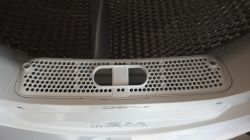

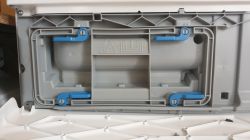
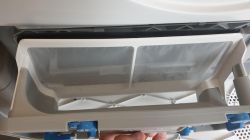
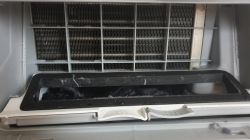
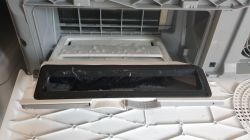
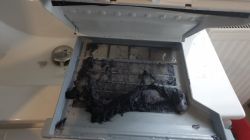
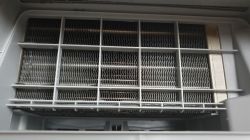
And a few more details about what this lint filter looks like. In order not to describe, I just took photos. As you can see, everything flows from the drum through a typical chamber in the door casing, but nothing stops there, but is sucked lower towards the condenser. The first container has a dense filtering mesh right in front of the condenser (so probably in the way of the strongest air draft), but it is positioned at an angle of approx. 45 degrees. It seems to me that these flocs fall by gravity into the lower reservoir where they accumulate. There is little fluff in the upper tank, just a little on the mesh in front of the condenser. The capacitor is accessible from the front and from the bottom (in case someone wanted to vacuum it. I think that at the back of the dryer I also saw an easily removable module at the same height, which should give access to the back of the capacitor.
zygit78 wrote:I am also wondering about the Bosch 8 series with AutoClean - exactly WTX87K40PL (until tomorrow I found a ray on a certain page). From what I've seen and read about these different dryers, Self Cleaning Condenser should rather be avoided. In most Bosch models with this self-cleaning capacitor / condenser (actually an evaporatorbecause only he is washed) there is no access to it without making some modifications like cutting holes. For me, this solution is out of the question, because I do not want to believe that the water that flows by gravity on this heat exchanger will remove any of these lamellae. In addition, soaking this muck will only help it stick to the surface of the lamellas. However, the latter solution, half a thousand to a thousand more expensive, looks promising. The AutoClean has a service hatch to access the evaporator, it also has a mesh filter mounted diagonally in the service hatch, which is rinsed with water and flushes the lint into a removable tank that is underneath. It looks ok. You can even see in some videos a few seals that seem solid and possibly seal the whole thing well (better than the inserts at the drum door). The advantage is also that it is not necessary to clean the filter in the drum door after each use of the dryer. I am still struggling with the purchase, but I will rather buy it tomorrow. In addition, I checked the instructions and there are two "maintenance" programs on this particular dryer, so you don't need to enter any service menu to test individual dryer components to force a few rinses to clear most of the muck from the system.
Tadek_Maciejewski wrote:For me, this heater is constructed using a heating coil, or actually two (power regulation). The cost of the heating coil itself is about PLN 20 and you can easily "wind" it yourself in the dryer radiator. It will probably be the same in yours.In the event of a heater failure, replacement costs PLN 300-400.
Tadek_Maciejewski wrote:From my experience, I doubt that this difference will be as much as PLN 100 a year.The difference of PLN 100 per year in the price of electricity will never be amortized when the equipment is replaced every 3-4 years.
Tadek_Maciejewski wrote:There are no cheaper ones on the market? A dryer without a heat pump has a structure reminiscent of a simple flail. You can buy the cheapest one, and it will work anyway :-)I am just ordering a Bosch condenser with heater. Equipment price: PLN 1700.
Dorilll wrote:Well, the difference is that the one that dries in 80 degrees, and the old one is dried in 50
internick wrote:You didn't help, gentlemen
Dorilll wrote:I once read about Samsung that it is difficult to clean the exchanger because there is poor access, deeply hidden.
Dorilll wrote:Or the sleeves shortened by a few cm ... I know it from my own experienceI recommend you the mixed XL program, it is 6 kg and softer than cotton

